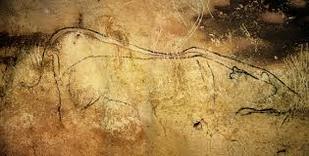The visual brain, embodiment, and the first visual cultures: what can they tell us about "art"
 Derek Hodgson
Derek Hodgson I learned from Derek that while we are not SEEING the legs of certain animals painted in prehistoric caves, our human ancestors were probably KNOWING these animals had legs (ex: pictures 1 and 2). A line was enough to embody the notion of horse, or lion etc. With our current brain, we can even SEE that these ancestral representations of nature ranged on a scale of ambiguity, from highly representative depiction of animals, to camouflage art.
This suggests that the prehistoric visual brain already KNEW how to fill in the missing parts, which shows a certain ability of abstraction. As a matter of fact, Derek showed us some striking similarities between some visual patterns found on the walls in Lascaux, clearly on the ambiguous side of the spectrum, and Mondrian paintings (pictures 3 and 4). Derek also reminded us that the visual brain prioritize the processing of vertical and horizontal lines over other visual inputs in general, which sounded particularly relevant here.
As for Francisco Steen's presentation, I was again pleased to travel through time and imagine how our ancestors' brain functioned, but quite dismounted by the degree of interpretation based solely on visualization of very old paintings. What if the squares in picture 3 were actually the painter trying out new colors?
Finally, I read online about Derek's interest in primates. I wonder if monkeys also paint like Mondrian? As a matter of fact, at a chimpanzee art context in 2013, the painting of the chimpanzee who won the $10.000 first prize shared some vague similarities with Mondrian and the Lascaux painting (picture 5). Does this validate Derek's working hypothesis? (even knowing the chimpanzee painted it with her tongue?)
Finally, I read online about Derek's interest in primates. I wonder if monkeys also paint like Mondrian? As a matter of fact, at a chimpanzee art context in 2013, the painting of the chimpanzee who won the $10.000 first prize shared some vague similarities with Mondrian and the Lascaux painting (picture 5). Does this validate Derek's working hypothesis? (even knowing the chimpanzee painted it with her tongue?)
This is part of a series of posts on the 11th International Conference on Neuroesthetics (September 2014).





 RSS Feed
RSS Feed